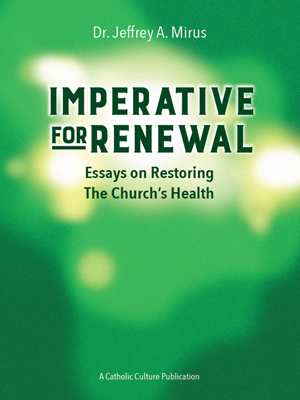Let’s stop pretending: something DID go wrong after Vatican II
By Phil Lawler ( bio - articles - email ) | Aug 23, 2017
Something went wrong—seriously wrong—in the Catholic Church in the years after Vatican II. Can we all agree on that much? Leave aside, for now, the familiar debate about the causes of the problem; let’s begin with the agreement that there is, or at least certainly was, a problem.
Free eBook:

|
| Free eBook: Imperative for Renewal |
Eric Sammons makes the point in a provocative essay that appeared in Crisis last week:
If an entirely objective social scientist were to study the Catholic Church in the second half of the twentieth century, he would see one fact staring him straight in the face: the Church experienced a precipitous decline in the Western world during that time.
The problem (whatever it is) is compounded, Sammons remarks, by a general refusal to acknowledge the reality of our post-conciliar difficulties: what he terms a “soft censorship” of unpleasant news. Bishops and pastors, diocesan newspapers and parish bulletins have bombarded us for years with reports that the Church is “vibrant,” that programs are booming, that the liturgy is beautiful, that religious education is robust. Never is heard a discouraging word. Yet we know better. We know about the shortage of priests; we see the news of parish closing; we notice the empty pews on Sundays. Something is wrong; we know that.
Sammons argues persuasively that this “soft censorship,” this see-no-evil approach, is now an impediment to evangelization, because it thwarts serious discussions about the current state of the Church. Evangelization means bringing people to the truth, he reasons, and that process “cannot thrive in a censored environment.”
In another excellent essay, which had appeared a week earlier in First Things, the German author Martin Mosebach explored the catastrophic confusion and disorientation that visited the Church in the years after Vatican II, as the lives of ordinary parishes were disrupted by radical theological views and liturgical experiments. He notes:
To be fair, we should remember that the popes attempted to counter this—with a weak voice and above all without the will to intervene in these aberrations with an organizing hand as the ruler of the Church. Only a very few individual heresiarchs were disciplined—those who with their arrogant insolence practically forced their own reprimand. But the great mass of the “new-Pentecostals,” unrestrained and protected by widespread networks, could continue to exercise a tremendous influence on the day-to-day life of the Church. So, for outside observers, the claim that with Vatican II the Church had broken with her past became ever more probable.
Both Sammons and Mosebach see three standard interpretations of Vatican II:
- The “liberal” or “progressive” interpretation sees the Council as a decisive break with Catholic tradition, and welcomes it. Citing the “spirit of Vatican II,” proponents of this interpretation have implemented radical changes in the Church, and push for more.
- The “official” interpretation sees Vatican II as a great success, and denies that any serious problems arose in the Council’s aftermath. There was some understandable friction as changes were implemented, the partisans of this theory will concede. But ultimately the changes are proving successful and all is well.
- The “conservative” or “orthodox” interpretation cherishes the documents of Vatican II, but believes the implementation of the Council was generally hijacked by the “progressive” party within the Church. If only we would adhere to the true teachings of the Council, this party says, the Church would thrive once again.
According to this “conservative” or “orthodox” interpretation, the hijacking of the Council created the incorrect impression that the Church had repudiated past teachings. My favorite quick exposition of this view was made by Philip Trower in his excellent book, Turmoil and Truth, in which he formed a vivid image to explain what happened:
Six men are pushing a heavily loaded car which has run out of fuel. Three of them, who have been riding in the car, want to push it 20 yards to get it into a lay-by. The other three, who have offered to help, mean to push the car 50 yards and shove it over a cliff followed by the car owner and his two friends. Once the pushing begins and the car starts moving it is probable the car is going to come to rest more than 20 yards from the starting point even if it does not end up at the cliff’s foot.
Now let us imagine what a group of people watching from a nearby hilltop will make of the incident. They will start by assuming that all six men have the same intentions. The car is moving steadily forward. Then they see three of the men detach themselves from the back of the car, run around to the front and try to stop it. Which are the troublemakers? Those surely who are now opposing the process that has been started.
The “liberal” interpretation is obviously wrong, because it ignores both the content of the Council’s teaching and the truth of Catholic history. As Pope Benedict XVI took pains to explain, the work of the Council must be understood in the context of the Church’s constant teaching. Only a “hermeneutic of continuity” can ensure a proper understanding. The Council was not a break with previous Church teaching; the Church, by her very nature, cannot break with her own past. To suggest that previous teachings were wrong, and only now are we getting things right, is to deny that the Church is and always has been guided by the Holy Spirit.
The “official” interpretation is also obviously wrong, because it ignores the reality that—despite the censorship exercised by house organs—we see all too clearly around us. The life of the Catholic Church is, sadly, not vigorous. Congregations are shrinking; young people are leaving. Yes, there are success stories; the Spirit has not abandoned the Church. But the overall trend-lines, which veered so steeply downward through the latter half of the 20th century, are still not encouraging.
But what about the “conservative” interpretation? Is it persuasive? Can it be reconciled with the facts? Sammons and Mosebach argue that the time has come for a frank—that is, uncensored—discussion of these questions.
Did the problems that arose after Vatican II come solely because the Council’s teachings were ignored, or improperly applied? Or were there difficulties with the documents themselves? Were there enough ambiguities in the Council’s teaching to create confusion? If so, were the ambiguities intentional—the result of compromises by the Council fathers?
Suggesting that there could be difficulties with some Vatican II documents does not mean denying the authority of the Council’s teaching. No document drafted by human hands will ever be perfect. There may be a need for clarification, elucidation, explanation, even correction.
More to the point, while it is certainly true that the “spirit of Vatican II” that is often cited in support of radical changes cannot be reconciled with the actual teachings of the Council, it is also true that the proponents of change can cite specific passages from Council documents in support of their plans. So are those passages being misinterpreted. Are they taken out of context? Or are there troublesome elements of the Council’s teaching, with which we should now grapple honestly? One thing is certain: we will not solve the problem by pretending that it does not exist.
All comments are moderated. To lighten our editing burden, only current donors are allowed to Sound Off. If you are a current donor, log in to see the comment form; otherwise please support our work, and Sound Off!







